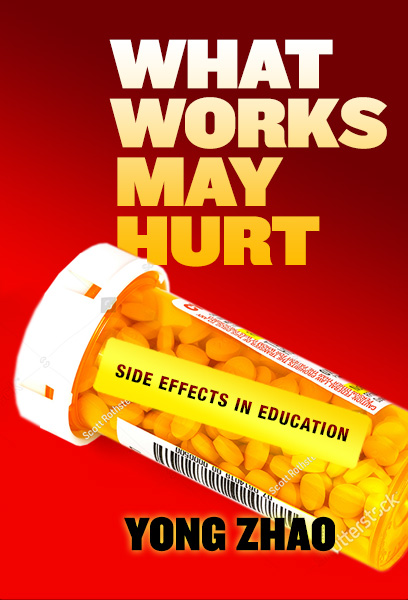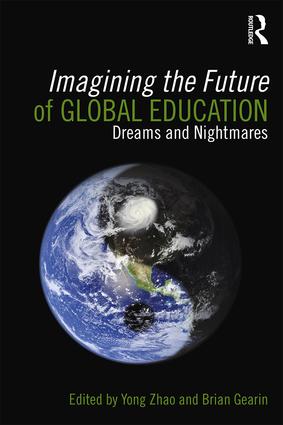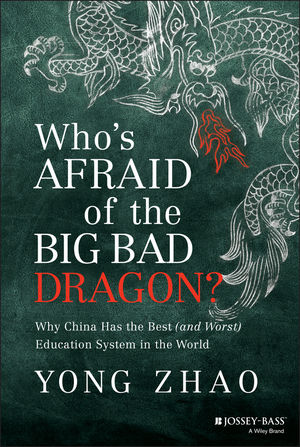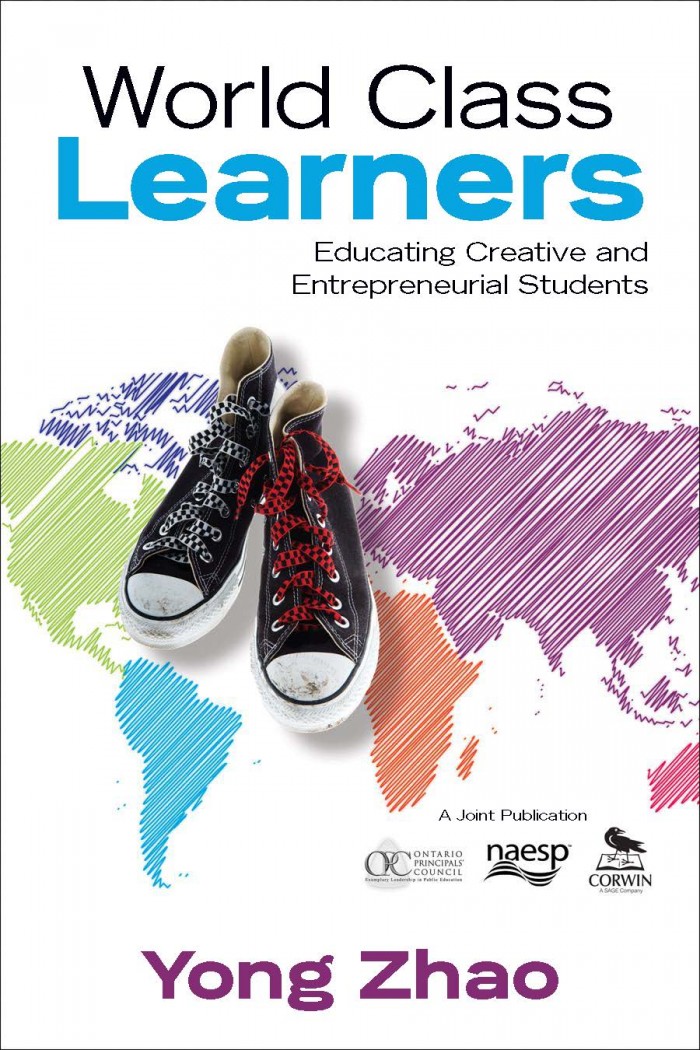Pass the book, but which one?
Pass the book, but which one?
To be globally competitive, we should all begin to use chopsticks because chopsticks produce better education outcomes as measured by the international gold standard of education the OECD’s PISA, which tests 15 year olds in math, reading, and sciences, and TIMSS, which assess 9-10 and 13-14 year olds math and science abilities. The top five performers in the 2009 PISA math (Shanghai, Taiwan, Singapore, South Korea, and Japan) all use chopsticks, so do the top five in TIMSS math in 2007 (Singapore, Taiwan, South Korea, Japan, and Hong Kong), in 2003, and 1999. And PISA and TIMSS scores are what drive nations’ economic growth and back their global competitiveness.
Such is the logic of the New York Times columnist Thomas Friedman and OCED’s PISA group, exemplified by Friedman’s March 11th, 2012 column Pass the Book, Hold the Oil. Citing a correlational analysis between PISA math scores and the total earnings on natural resources as a percentage of GDP, Friedman attempts to prove a point that does not need to be proven: education matters.
There are two problems with this reasoning.
First: correlation does not mean causality. Anyone who has taken an introductory statistics would know the example of the correlation between the number of churches and prostitutes. While there exists a positive correlation between the two, one cannot conclude that the increase in the number of churches causes the increase in the number of prostitutes. Similarly, the negative correlation between PISA math scores and earnings on natural resources does not necessarily mean that fewer natural resources cause high PISA scores (hence better education) or vice versa. While some countries with limited resources performed well in the PISA, there are plenty of countries with limited natural resources that don’t. And countries with more natural resources did not all produce lower scores, as Friedman noted. But of course, these countries are just smart enough to invest their earnings in education—a very nice way to brush aside this inconvenient fact.
Second: not all education is the same. I wholeheartedly support the suggestion that education matters, but the question is what kind of education. The PISA advocates attempt to equate PISA scores with educational quality, then global competitiveness. But that connection may not be as justified as it is made to be. Israel, for example, praised by Andreas Schleicher, who directs the PISA program, as “one of the most innovative economies” has not had a great show in the PISA since its first participation. In 2009, Israel’s 15 year olds’ math scores put it in the 41st place, 49 points below OECD average (and the U.S. took the 30th place).
The case is even better illustrated with Taiwan, the anchor point of Friedman’s essay.
Over the past 60 years, Taiwan’s education has co-evolved with its economic, political, and social development. In other words, Taiwan has not always had the education it has today. Therefore, one cannot automatically link the state of education at one moment in time to its economic development of the moment. The PISA may measure something useful for certain societies at certain economic development stage, but it does not measure everything that drives nations’ economic growth at different development stages.
Tu Cheng-sheng, Taiwan’s Education Minister, recounts Taiwan’s education and economic history in a 2007 speech he delivered in the London School of Economics:
In order to popularize education, the KMT government, in 1968, extended the schooling years of compulsory education from 6 to 9. Students aged 6 to 15 have since been entitled to receiving a free education. When the policy was initiated, Taiwan’s economy had not taken off yet; the government was not financially sound, and there were not sufficient teachers and facilities. In retrospect, this policy, which was decided by President Chiang Kai-Shek, proved to be a correct one; the quality of Taiwan’s human resources has therefore been elevated.
In the 1960s, private junior colleges were allowed to be set up and to provide more students with vocational education and technical training. Under the Japanese rule, Taiwan’s technical and vocational education had the attention of the colonizers; yet, it was limited to the secondary school level. The KMT’s decision to raise the level of technical people up to junior college level has made a great contribution to Taiwan’s economic development.
At that time, Taiwan’s economy rested on labor-intensive, export-oriented industries producing livelihood-based home-use goods and aiming to open up international trade. Many five-year junior colleges were established to provide students aged 16 to 20 with industrial and commercial vocational education and training. When students graduated, at the age of 20, they were equipped with basic job skills and were ready for work. Higher-quality manpower thus met the needs of the development of industry and business and created Taiwan’s economic miracle of the mid-70s. Taiwan successfully transformed itself from an agricultural society to an industrial and business society and, together with South Korea, Hong Kong and Singapore, was known as one of “Four Tigers in Asia.”
In the late 1980’s, Taiwan’s economy took another turn. High-tech industry gradually became the focal point of economic development, needing different types of human resources. To meet the new demand, more higher education institutions were needed to cultivate higher-level technical people.
…
Taiwan’s industry started from export-oriented processing and developed through the stages of contract manufacturing and high-tech industries. Though we have thus earned sizeable revenues, we are still lacking in the development of our own brand names. The creation of new international known brand names is closely linked to a culture-based creative industry. To compete with others, Taiwan should produce its own brand name goods by integrating advanced technology and rich cultural content. This new industry will be of crucial importance to the future growth of Taiwan.
In order to better prepare our students for the future, we have made several changes in education policies. On the senior high school level, students are given more time to understand their own aptitude and interests. The policy regarding students’ choice of the field of study at senior high schools has been modified. In the past, students had to decide which field of study to concentrate on, in the 11th grade. Now, they can wait until the last year of senior high school to choose between humanities and social sciences and life and natural sciences. On the college level, we are promoting a policy which allows college students to choose their departments in their second year. We are also strengthening general education and cross-disciplinary studies. More programs will gradually replace traditional academic departments. These changes rely on the conceptual as well as structural reform in Taiwan’s higher education sector.
The education journey of Taiwan is one from authoritarian government control to education liberation:
The reforms brought about by the liberalization of education, such as the freedom extended to private presses to compile and publish textbooks and the establishment of multiple channels to admit students to higher levels of schools, are vastly different from the previous policies or measures, which allowed only one definite set of textbooks and only unified way of admitting students.
Taiwan society has been deeply influenced by Chinese examination culture. As we all know, the age-old and long-lasting Chinese examination system used to be praised for its impartiality; people from all walks of life could take the examination without discrimination. However, the tradition of holding such a fair examination exacted a huge price out of the nation, such as the loss of creativity and the enclosure of values.
There are lessons to be learned from Taiwan, for sure, but the lesson is that government control does not produce creativity, testing does not lead to economic prosperity in the creative economy, and standardization only works to produce uniform workers. Taiwan has gone through different stages of educational practices and has been working to invent an education that fits its future—more creativity, more entrepreneurs, and more innovators. And that education is more child-centered, less government interference, and more teacher autonomy, as the Taiwanese Education Minister said:
Education for creativity is based on the respect for individual values, which is relatively lacking in traditional Oriental societies. Taiwan’s education reform has walked out of bondage towards openness, which allows the pursuit of one’s own value system. Only when each individual within a society is respected, can that society permit the existence and growth of human rights, democracy, freedom and the rule of law.




























The article cites Andreas Schleicher who claims that recent results on the PISA indicate “a significant negative relationship between the money countries extract from national resources and the knowledge and skills of their high school population”. Indeed this is correlation, not causation, but it cannot be ignored either. Education in these countries is doing something that results in higher PISA scores. The question becomes, is this desirable?
The classroom is not a factory. We do not send our children to be educated through a mechanized structure that can guarantee a refined product capable of passing TIMMS.
A family and culture must value the opportunity and participate in the deep, mutual commitment necessary to obtain a quality education. Our culture must change what it values and what it is willing to contribute to the academic success of our youth.
Yet, this is not measured when we discuss the systems, or educational ‘factory’ aspect of academic success. I am a teacher. How can I educate a child that has missed 33% of school this year as well as for the last 3 years? When children regularly miss school, arrive sleepy due to watching movies until midnight on school nights, and other family choices that deplete the child of ‘school & learning readiness’, no school can wildly succeed. It is a collaboration between society’s values and a quality, flexible, and child-centered education system. Without this collaboration, the American K-12 classrooms are really just a factory working with students not prepared to learn.
We must discuss the society values and compare those of the countries where students excel at TIMSS as well as the educational systems in place. If we don’t, then we are only fooling ourselves by analyzing incomplete data and noting correlations, not causation. It is a hard look in the mirror- one that does not reflect a beautiful picture.
I recently gave a presentation on creativity in education at the Korean Educational Development Institute (KEDI). As part of that, I offered a news video about one American middle school’s great experience putting on a high quality “Broadway” musical. The video highlighted how parents, teachers, and students worked tirelessly for three months, 4 evenings a week, plus weekends, preparing the performance.
Of course, I wasn’t suggesting that Korean schools need to be just like American schools, but I was struck by one comment I received. It was along the lines of, “this is really amazing! But I would not want my child involved in this! He needs to be attending hogwan [cram school] to prepare for his college exam!]
The point is, imagine the valuable experiences American students would need to sacrifice in order to gain high PISA scores!
Feel free to comment:
The views expressed on this site are entirely my own. They do not represent my employer or any other organization/institution. All comments are subject to approval.Archive
03.17.24 Focused: Understanding, Negotiating, and Maximizing Your Influence as a School Leader
02.25.24 What Happened to Global Competence?
08.05.23 Rethinking the time spent at school: Could flexibility improve engagement and performance for students and teachers?
01.17.23 Introduction to Improbable Probabilities: The Unlikely Journey of Yong Zhao
01.05.23 How Not to Kill Creativity?
08.19.22 Preface to Improbable Probabilities: The Unlikely Journey of Yong Zhao
02.05.22 Introduction to New Book: Learning for Uncertainty: Teaching Students How to Thrive in a Rapidly Evolving World
09.25.21 Side effects in education: Taxonomy of educational outcomes
07.13.21 Introduction to My New Book: Learners without Borders
03.09.21 New article: Build back better: Avoid the learning loss trap
02.18.21 New article: The changes we need: Education post COVID-19
09.15.20 Watch Ep4 Creativity in Crisis: How well is creativity understood? A Conversation with Barb Kerr, Haiying Long, Ron Beghetto, & Yong Zhao
08.15.20 Can Creativity be Taught? Ep 3 of Creativity in Crisis on August 28th 3:00-4:00pm Pacific Time
07.13.20 Speak a Different Language: Reimagine the Grammar of Schooling
06.11.20 Assessing Creativity in the Classroom? Recording of Ep2 of Creativity in Crisis
Tag Cloud
Accountability achievement gap CCSSO China/Chinese Commissioner Common Core Standards education Educational Policy Education Reforms national standards New York NGA Singapore standardized testing Standards student performance
WP Cumulus Flash tag cloud by Roy Tanck and Luke Morton requires Flash Player 9 or better.
Silverliningforlearning
Most Commented
Most Viewed
Views expressed on this site are entirely personal. They do not necessarily represent the official positions or views of my employer
Powered by WordPress | Log in | Entries (RSS) | Comments (RSS) | Arthemia theme by Michael Hutagalung